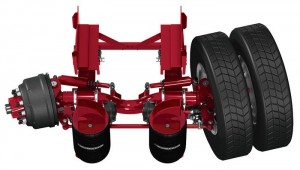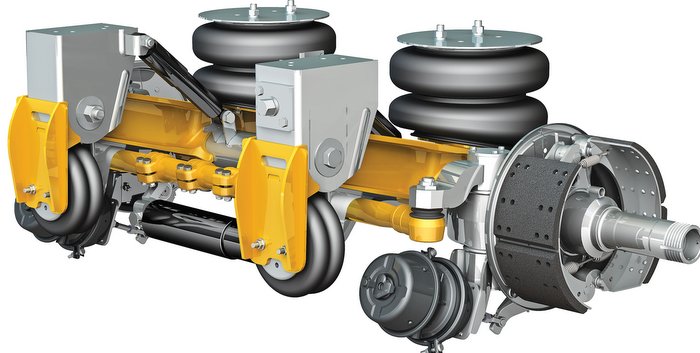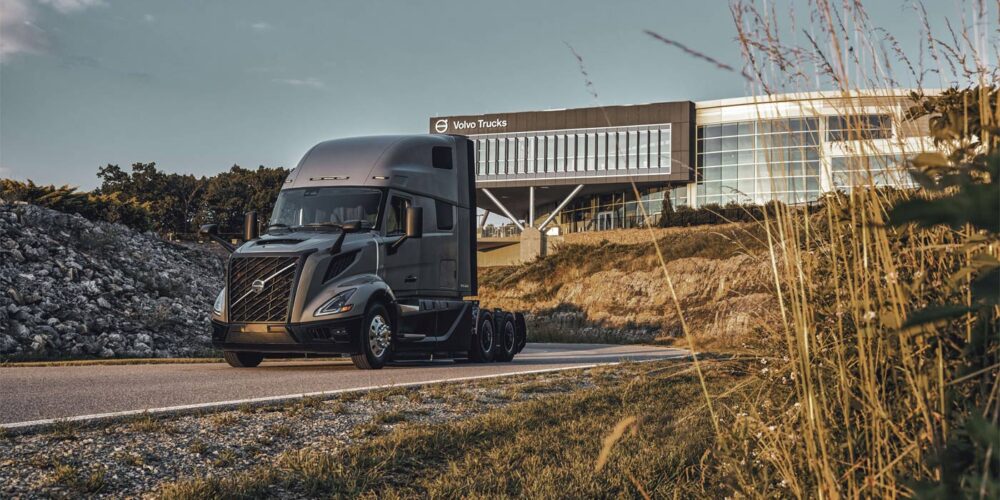Lift axles, so named for the attached air bags or springs that lift the axle off the road’s surface when it is not needed, are becoming an increasingly popular option for fleets. Lift axles can be mounted on either the truck or the trailer, and promise fuel and tire savings since the axle is only being used when necessary. They are especially useful for trucks that often cross state lines where the weight limits are different—the axles can be on the ground when extra weight is needed and off when efficiency is required. They come in two varieties: non-steerable lift axles that utilize a round trailer style, and steerable lift axles that use a forged I-beam style.
Lift axles are most often used with construction vehicles such as dump trucks, garbage trucks and concrete mixers, among others—but their usage in over-the-road applications has increased in recent years.
“Lift axles were traditionally used on vocational multi-axle trailers to improve the turning radius and to reduce tire scrubbing,” explains Bill Hicks of SAF-Holland trailer suspension systems—product planning. “However, recently there has been a significant increase in lift axle use on over-the-road applications including less than truckload [LTL], fuel delivery, beverage delivery, food service and multi-stop fleets. Fleets have found significant improvements in fuel consumption, tire life, and suspension component life by lifting axles when they are not needed to support the trailer load.”
SAF-Holland manufactures the 13,500-lb. steerable lift axle and the NEWAY LSZ13, with a 20,000-lb. lift axle to be launched soon. SAF-Holland also offers a number of trailer axles: The PosiLift, a bolt-on lift system designed for CBX fixed frame applications; the Auto-PosiLift, which combines PosiLift components with a unique electronic control unit (ECU) and valve system; the heavy-duty PosiLift, designed to lift CBX self-steering axles while backing up, tight maneuvering in a yard or worksite, or when running empty; and the CBL, a center bag lift design for all CBX fixed frame models which mounts below the frame rails centered between the suspension hanger brackets.
“Lift axles work best in applications where the tare load and the maximum operating load vary greatly,” relates Paul Brown, marketing manager for Hendrickson, which offers a variety of steerable and non-steerable

axles for both trucks and trailers, including the Composilite and Toughlift product lines. “Refuse trucks typically demand more ground clearance, where construction applications may prefer additional load capacity.”
“The use of lift axles can improve fuel economy for comparable trucks specified with non-lift axles,” adds Sam Sather of Hendrickson applications engineering. “Lifting the axle when the gross vehicle weight does not require all of the axles reduces road drag, and improves load share on the remaining axles allowing components such as brakes to perform closer to their optimum condition.”
Reyco Granning offers lift axles including the ALAP-13, a 13,200-lb. axle with a steerable and non-steerable option; the L225, a 22,500-lb. non-steer option; and the T200AX and T200AM, their highest-lifting non-steerable axles which come in 12-, 16- and 19,000-lb. ratings.
“The most important thing to remember is to make sure your dealer understands what your needs are when spec’ing your lift axle configuration,” advises Jason Heath, SAF-Holland’s product manager of powered vehicle systems. “For example, if your objective is to maximize payload, the dealer will likely configure a truck with multiple pusher axles and a tag axle. If you are concerned with improving fuel economy, you will need to reduce rolling resistance and weight.”














